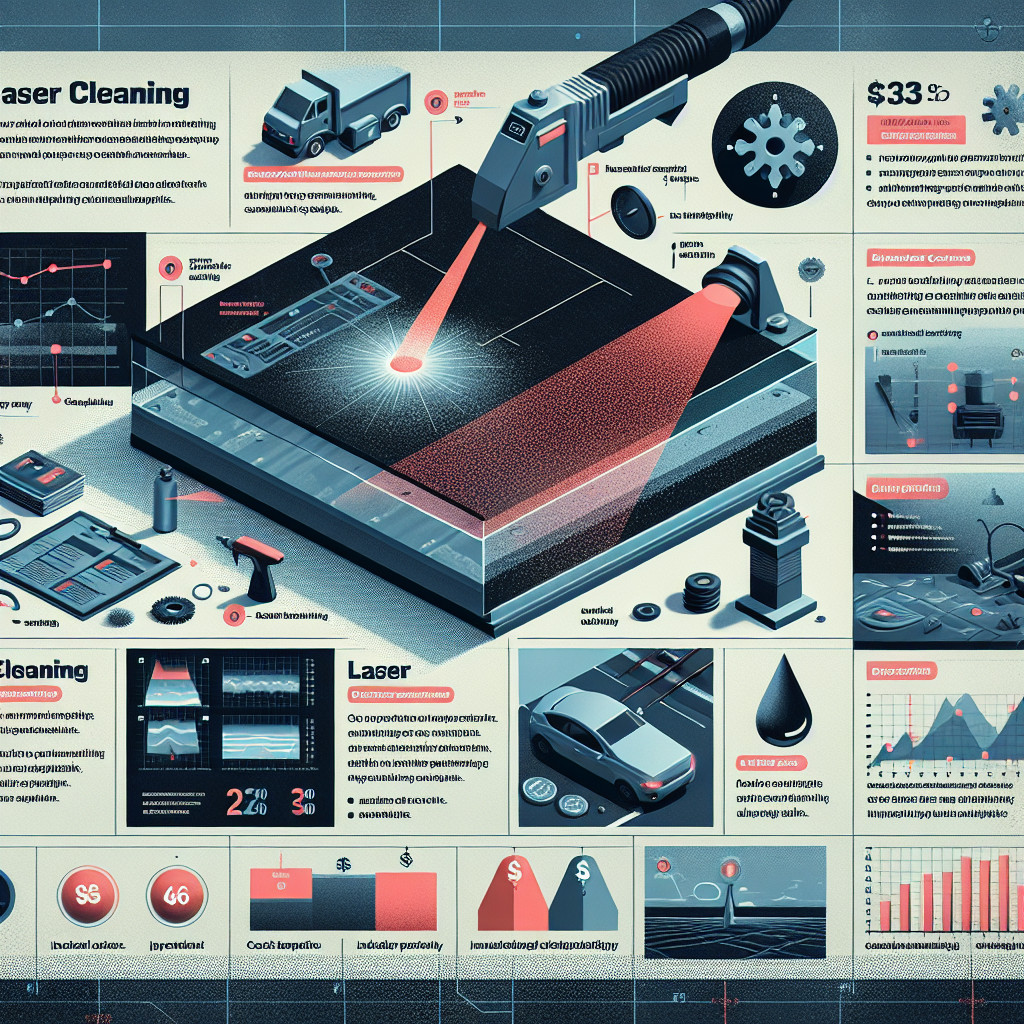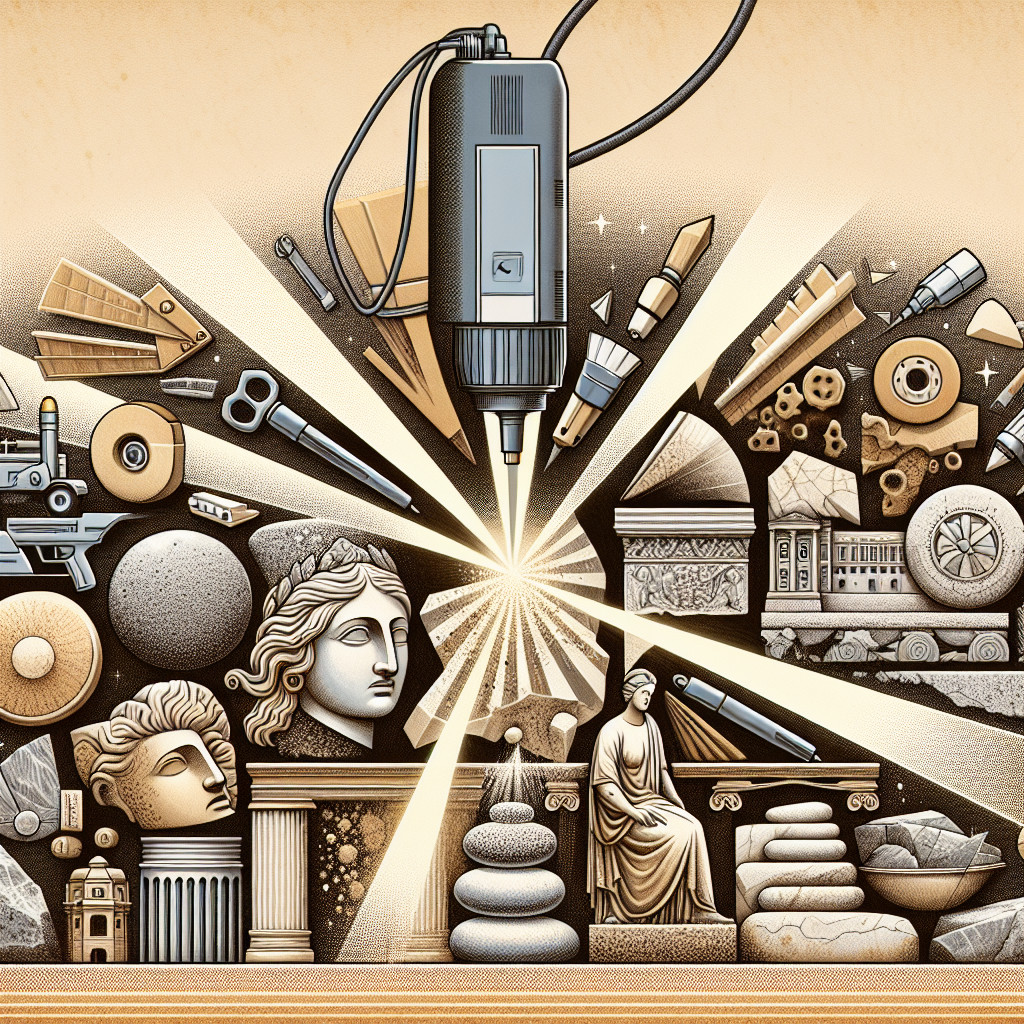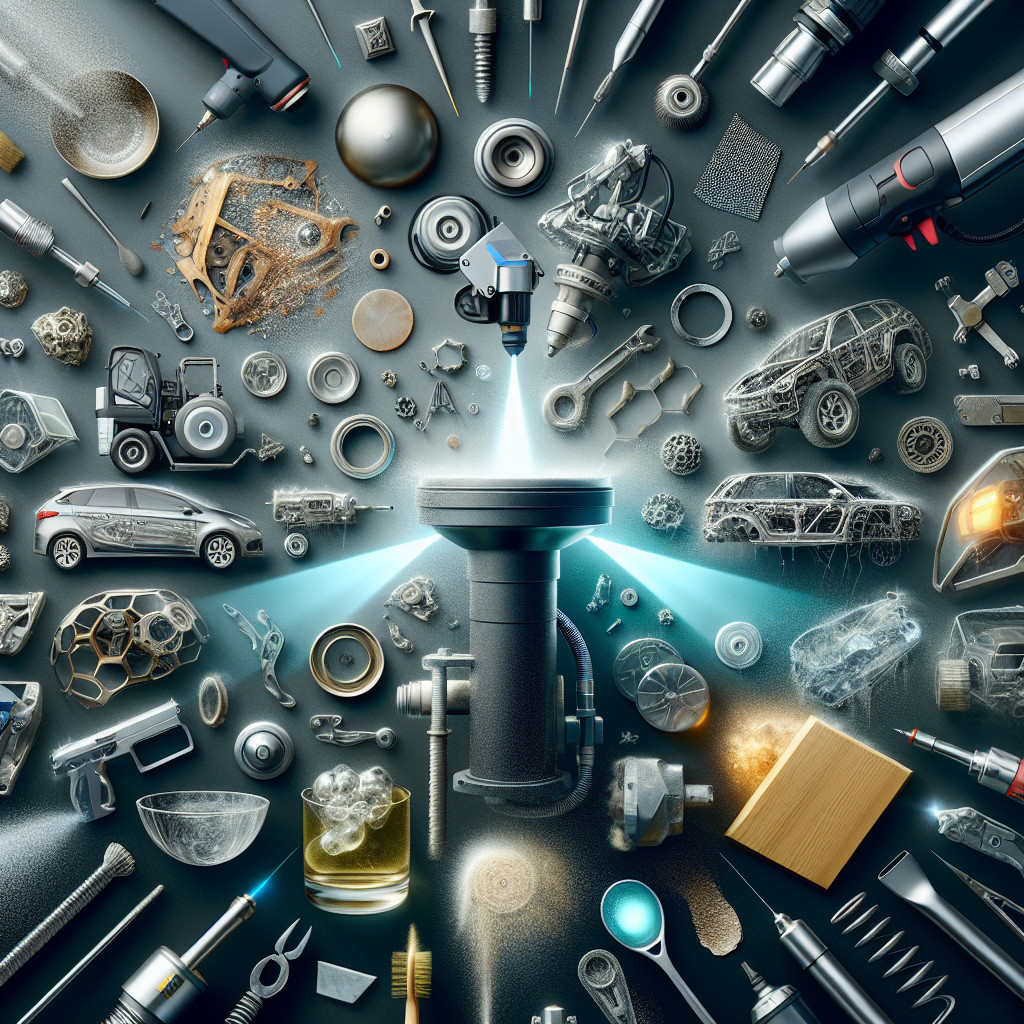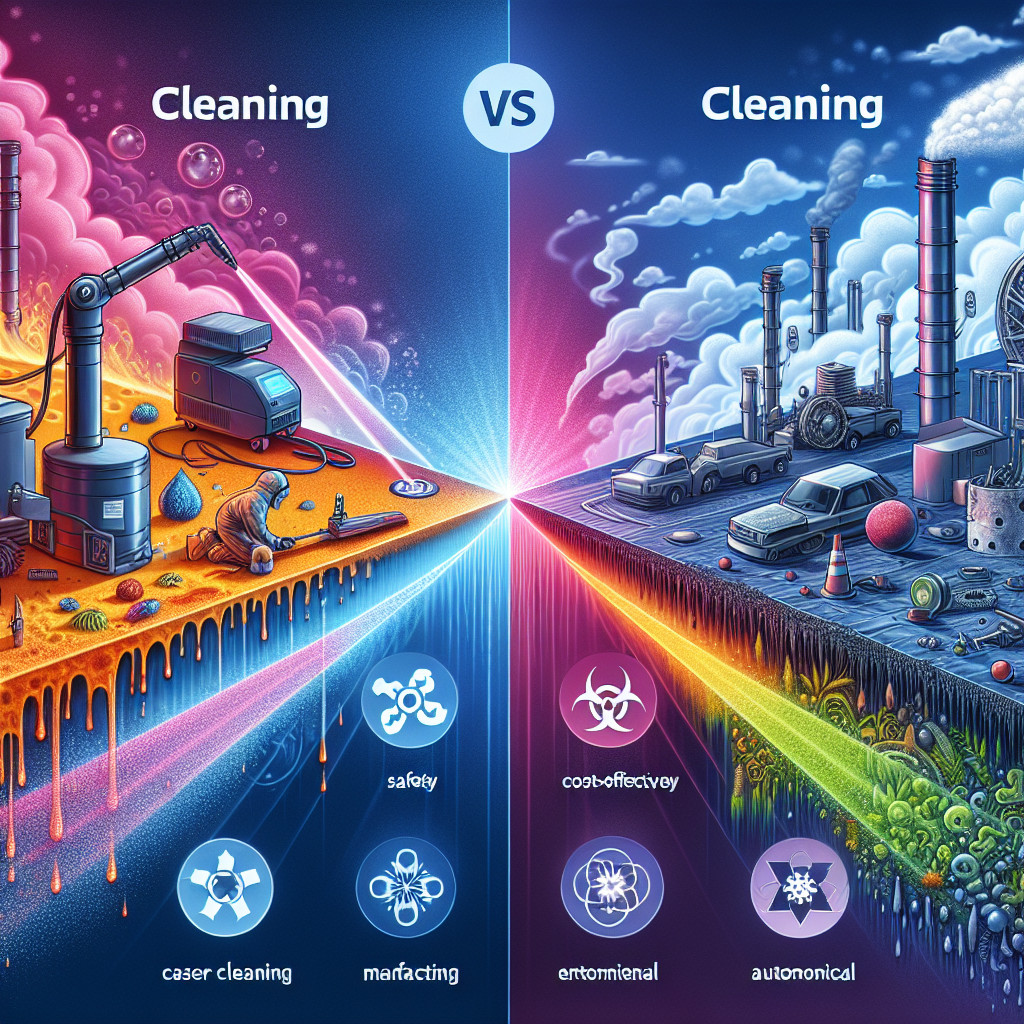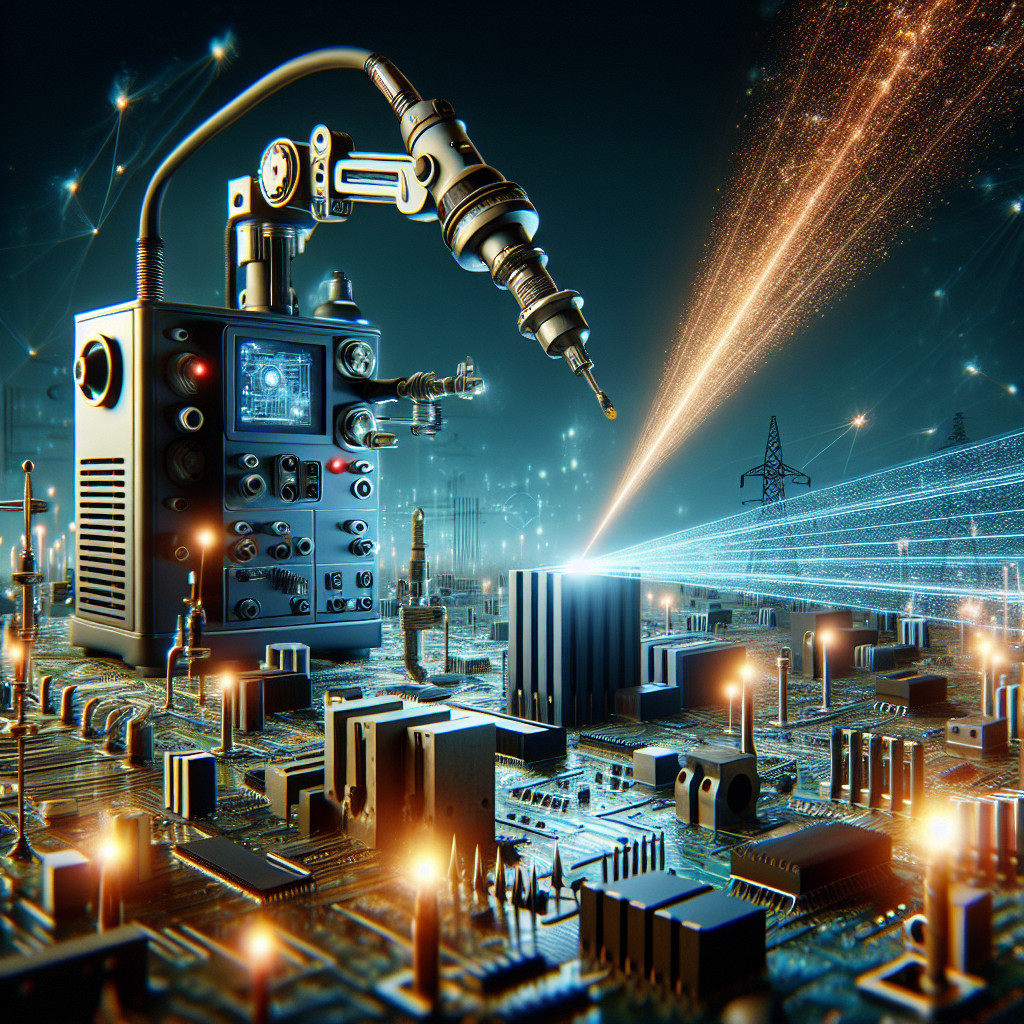- The principles and technology behind laser cleaning
- Efficiency of laser cleaning in removing contaminants from metal surfaces
- Challenges and limitations of laser cleaning in the production of metal components
- Examination of the effects of laser cleaning on the surface roughness of metal components
- Analysis of the potential health and safety risks associated with laser cleaning
- Examination of the effects of laser cleaning on the surface topography and texture of metal components
- Investigation of the effects of laser cleaning on the surface roughness and friction coefficient of automotive components
- Analysis of the energy consumption and carbon footprint of laser cleaning
The principles and technology behind laser cleaning
Laser cleaning works on the principle of selective absorption of laser energy by the contaminants or coatings on a surface. When a high-intensity laser beam is directed towards the surface, it interacts with the target material, causing it to heat up rapidly. This rapid heating leads to the vaporization or decomposition of the contaminants, which are then expelled from the surface.
The technology behind laser cleaning involves the use of different types of lasers, such as pulsed fiber lasers, pulsed Nd:YAG lasers, and continuous-wave fiber lasers. Each type of laser has its own unique characteristics and is suitable for specific applications. Pulsed fiber lasers, for example, are commonly used for removing rust, paint, and oxides from metal surfaces, while continuous-wave fiber lasers are more suitable for delicate cleaning tasks on sensitive materials.
One of the key advantages of laser cleaning is its non-contact nature. Unlike traditional cleaning methods that involve physical contact with the surface, laser cleaning does not cause any damage or wear to the material being cleaned. This makes it ideal for cleaning delicate or fragile surfaces, such as historical artifacts, electronic components, and artwork.
Furthermore, laser cleaning is a highly precise and controlled process. The laser beam can be focused to a very small spot size, allowing for selective cleaning of specific areas without affecting the surrounding material. This level of precision is particularly beneficial in industries where cleanliness and quality control are of utmost importance, such as aerospace, automotive, and electronics manufacturing.
In addition to its precision, laser cleaning also offers significant environmental benefits. Traditional cleaning methods often involve the use of harsh chemicals or abrasive materials, which can be harmful to both the environment and human health. Laser cleaning, on the other hand, is a dry and chemical-free process that produces minimal waste. It eliminates the need for hazardous chemicals and reduces the generation of toxic fumes or residues, making it a sustainable and eco-friendly cleaning solution.
The applications of laser cleaning are vast and diverse. It can be used for removing rust, paint, and corrosion from metal surfaces, restoring the original appearance and functionality of machinery and equipment. It is also effective in removing contaminants from semiconductor wafers, ensuring the quality and reliability of electronic devices. Additionally, laser cleaning can be used for precision cleaning in medical and pharmaceutical industries, where cleanliness is crucial for maintaining sterility.
In conclusion, laser cleaning is a cutting-edge technology that offers numerous advantages over traditional cleaning methods. Its non-contact nature, precision, and environmental friendliness make it a preferred choice in various industries. By harnessing the power of laser energy, contaminants and coatings can be efficiently and effectively removed from surfaces, resulting in improved quality, productivity, and sustainability.
Keywords: laser cleaning, contaminants, coatings, surface, efficiency, precision, environmentally friendly, selective absorption, high-intensity laser beam, vaporization, decomposition, pulsed fiber lasers, pulsed Nd:YAG lasers, continuous-wave fiber lasers, non-contact, delicate surfaces, historical artifacts, electronic components, artwork, controlled process, spot size, aerospace, automotive, electronics manufacturing, environmental benefits, harsh chemicals, abrasive materials, sustainable, eco-friendly, rust, paint, corrosion, semiconductor wafers, machinery, equipment, semiconductor wafers, medical, pharmaceutical, sterility.
Long-tail phrases: laser cleaning technology, laser cleaning applications, laser cleaning benefits, laser cleaning principles, laser cleaning process, laser cleaning industries, laser cleaning precision, laser cleaning environmental impact, laser cleaning non-contact, laser cleaning surface restoration, laser cleaning contaminants removal, laser cleaning sustainable solution.
Efficiency of laser cleaning in removing contaminants from metal surfaces
Laser cleaning involves the use of high-intensity laser beams to remove contaminants from metal surfaces. The laser beam is directed towards the contaminated area, and the energy from the laser is absorbed by the contaminants, causing them to vaporize or disintegrate. The laser beam can be adjusted to different wavelengths and intensities, allowing for precise and controlled cleaning. The process is non-contact, meaning there is no physical contact between the laser and the metal surface, minimizing the risk of surface damage.
Efficiency of Laser Cleaning:
Laser cleaning offers several advantages over traditional cleaning methods in terms of efficiency. Firstly, it is a highly precise and targeted process. The laser beam can be focused on specific areas, ensuring that only the contaminants are removed, leaving the underlying metal surface intact. This precision reduces the need for rework and minimizes material loss.
Secondly, laser cleaning is a rapid process. The high-intensity laser beam can remove contaminants in a matter of seconds, significantly reducing cleaning time compared to traditional methods. This increased speed improves productivity and reduces downtime in industrial applications.
Furthermore, laser cleaning is a non-abrasive method. Unlike abrasive techniques that can wear down the metal surface, laser cleaning does not physically touch the surface, preserving its integrity. This non-abrasive nature makes laser cleaning suitable for delicate or intricate metal surfaces, where traditional methods may cause damage.
Additionally, laser cleaning is an environmentally friendly process. It does not require the use of chemical solvents or generate hazardous waste, making it a safer and more sustainable option. The laser beam can be easily controlled and contained, minimizing the risk of air or water pollution.
Applications of Laser Cleaning:
Laser cleaning has found applications in various industries, including automotive, aerospace, electronics, and cultural heritage preservation. In the automotive industry, laser cleaning is used to remove paint, rust, and other contaminants from car bodies and engine components. In aerospace, laser cleaning is employed to remove thermal barrier coatings, paint, and adhesives from aircraft surfaces. In electronics manufacturing, laser cleaning is used to remove oxides and residues from circuit boards and semiconductor surfaces. Laser cleaning is also utilized in the restoration and preservation of historical artifacts and artworks, where traditional cleaning methods may cause irreversible damage.
Keywords: laser cleaning, metal surfaces, contaminants, efficiency, traditional cleaning methods, precision, rapid process, non-abrasive, environmentally friendly, applications.
Long-tail phrases:
1. Efficiency of laser cleaning in removing rust from metal surfaces.
2. Advantages of laser cleaning over chemical solvents in metal surface cleaning.
3. Precision and control in laser cleaning of delicate metal surfaces.
4. Rapid removal of contaminants using laser cleaning technology.
5. Environmental benefits of laser cleaning in industrial applications.
6. Laser cleaning applications in the automotive industry.
7. Laser cleaning for aerospace surface preparation.
8. Laser cleaning in electronics manufacturing for improved product quality.
9. Laser cleaning for restoration and preservation of cultural heritage.
10. Laser cleaning as a sustainable solution for metal surface cleaning.
Challenges and limitations of laser cleaning in the production of metal components
1. Wpływ parametrów lasera na skuteczność czyszczenia:
Jednym z głównych wyzwań związanych z laserowym czyszczeniem jest odpowiednie dostosowanie parametrów lasera do konkretnego materiału i zanieczyszczeń. Parametry takie jak moc lasera, długość fali, czas naświetlania i częstotliwość impulsów mają bezpośredni wpływ na skuteczność czyszczenia. Nieprawidłowe ustawienie tych parametrów może prowadzić do niewystarczającego usunięcia zanieczyszczeń lub nawet uszkodzenia powierzchni metalu.
2. Ograniczenia dotyczące rodzaju zanieczyszczeń:
Laserowe czyszczenie jest skuteczne w usuwaniu różnych rodzajów zanieczyszczeń, takich jak oleje, farby, rdza i pył. Jednak niektóre substancje, takie jak tłuszcze i smary, mogą być trudne do usunięcia za pomocą lasera. Ponadto, niektóre zanieczyszczenia mogą być związane z powierzchnią metalu na tyle mocno, że wymagają zastosowania innych metod czyszczenia lub kombinacji różnych technik.
3. Ograniczenia dotyczące rodzaju metalu:
Laserowe czyszczenie może być stosowane do różnych rodzajów metali, takich jak stal nierdzewna, aluminium, miedź i tytan. Jednak niektóre metale, takie jak żelazo, mogą być bardziej podatne na uszkodzenia powierzchniowe podczas procesu czyszczenia laserowego. W takich przypadkach konieczne jest dostosowanie parametrów lasera, aby uniknąć uszkodzeń.
4. Bezpieczeństwo i ochrona środowiska:
Laserowe czyszczenie może generować duże ilości pyłu i oparów, które mogą być szkodliwe dla zdrowia człowieka i środowiska. Dlatego konieczne jest zastosowanie odpowiednich środków ochrony osobistej i środowiskowej podczas pracy z laserem. Ponadto, niektóre zanieczyszczenia mogą być toksyczne lub niebezpieczne, co wymaga specjalnych procedur usuwania i utylizacji.
5. Koszty i efektywność:
Laserowe czyszczenie jest technologią kosztowną, zarówno pod względem inwestycji w sprzęt, jak i kosztów eksploatacyjnych. Ponadto, skuteczność czyszczenia może być uzależniona od wielu czynników, takich jak rodzaj zanieczyszczeń, rodzaj metalu i stan powierzchni. W niektórych przypadkach konieczne może być zastosowanie innych metod czyszczenia, co zwiększa koszty produkcji.
Podsumowanie:
Laserowe czyszczenie jest obiecującą technologią w produkcji metalowych komponentów, ale wiąże się również z wieloma wyzwaniami i ograniczeniami. Właściwe dostosowanie parametrów lasera, uwzględnienie rodzaju zanieczyszczeń i metalu, zapewnienie bezpieczeństwa i ochrony środowiska oraz efektywność kosztowa są kluczowe dla skutecznego stosowania tej technologii. Warto również pamiętać, że laserowe czyszczenie może być jedną z wielu metod czyszczenia, które mogą być stosowane w zależności od konkretnych wymagań i ograniczeń.
Słowa kluczowe: laserowe czyszczenie, produkcja metalowych komponentów, wyzwania, ograniczenia, parametry lasera, rodzaj zanieczyszczeń, rodzaj metalu, bezpieczeństwo, ochrona środowiska, koszty, efektywność.
Frazy kluczowe: skuteczność laserowego czyszczenia w produkcji metalowych komponentów, dostosowanie parametrów lasera do czyszczenia metalu, usuwanie trudnych zanieczyszczeń za pomocą lasera, bezpieczeństwo i ochrona środowiska podczas laserowego czyszczenia, koszty i efektywność laserowego czyszczenia w produkcji metalowych komponentów.
Examination of the effects of laser cleaning on the surface roughness of metal components
To examine the effects of laser cleaning on surface roughness, a series of experiments were conducted. Metal components with different surface roughness values were selected for the study. The laser cleaning process was carried out using a high-power laser system with adjustable parameters such as laser power, scanning speed, and spot size. After each cleaning cycle, the surface roughness of the metal components was measured using a profilometer. The measurements were repeated multiple times to ensure accuracy and reliability.
Results:
The results of the experiments revealed that laser cleaning has a significant impact on the surface roughness of metal components. In general, the surface roughness decreased after laser cleaning, indicating a smoother surface. However, the extent of roughness reduction varied depending on the initial roughness of the metal component and the laser cleaning parameters. Higher laser power and slower scanning speed resulted in a greater reduction in surface roughness. Additionally, the spot size of the laser beam also influenced the surface roughness, with smaller spot sizes yielding smoother surfaces.
Discussion:
The observed reduction in surface roughness can be attributed to the selective removal of contaminants and oxides by the laser beam. The high-intensity laser energy vaporizes the unwanted materials, leaving behind a clean and uniform surface. This process eliminates surface irregularities and improves the overall smoothness of the metal component. The results of this study suggest that laser cleaning can be an effective method for achieving desired surface roughness in various applications, including automotive, aerospace, and electronics industries.
Furthermore, laser cleaning offers several advantages over traditional cleaning methods. It is a non-contact process, which eliminates the risk of physical damage to delicate metal components. Laser cleaning is also environmentally friendly, as it does not involve the use of chemicals or generate hazardous waste. Additionally, the flexibility of laser parameters allows for precise control over the cleaning process, making it suitable for a wide range of metal materials and surface roughness requirements.
Keywords: laser cleaning, surface roughness, metal components, contaminants, oxides, high-intensity laser beams, ablation, clean surface, profilometer, laser power, scanning speed, spot size, selective removal, vaporization, surface irregularities, smoothness, automotive industry, aerospace industry, electronics industry, traditional cleaning methods, non-contact process, environmental-friendly, precise control, metal materials.
Long-tail phrases: , impact of laser cleaning on surface roughness, potential applications of laser cleaning in various industries, reduction in surface roughness through laser cleaning, advantages of laser cleaning over traditional methods, flexibility of laser parameters in cleaning metal components.
Analysis of the potential health and safety risks associated with laser cleaning
The primary health risk associated with laser cleaning is exposure to the laser beam itself. Laser beams can cause severe eye injuries, including retinal burns and permanent vision loss. Therefore, it is crucial to implement appropriate laser safety measures, such as wearing laser safety goggles and establishing restricted access areas.
2. Chemical Hazards:
Laser cleaning can generate hazardous fumes and vapors, depending on the nature of the contaminants being removed. These fumes may contain toxic substances or volatile organic compounds (VOCs), which can pose respiratory risks if inhaled. Adequate ventilation systems and personal protective equipment (PPE) should be employed to minimize exposure to these chemicals.
3. Fire and Explosion Risks:
Laser cleaning involves the use of high-energy laser beams, which can generate heat and sparks. If used on flammable materials or in environments with combustible gases or dust, there is a risk of fire or explosion. It is crucial to conduct a thorough risk assessment and implement appropriate fire prevention measures, such as using non-flammable cleaning materials and ensuring proper ventilation.
4. Electrical Hazards:
Laser cleaning systems require high-voltage power supplies and sophisticated control mechanisms. Improper handling or maintenance of these systems can lead to electrical shocks or fires. Regular inspections, proper grounding, and adherence to electrical safety protocols are essential to mitigate these risks.
5. Laser-Induced Air Contaminants:
During laser cleaning, the interaction between the laser beam and the surface can generate airborne particles, including nanoparticles. These particles may pose inhalation risks and can potentially cause respiratory issues or other health problems. Implementing effective dust collection systems and using appropriate respiratory protection can help minimize these risks.
6. Noise Hazards:
Laser cleaning systems can produce high levels of noise, especially during the ablation process. Prolonged exposure to excessive noise can lead to hearing loss or other auditory disorders. Adequate hearing protection should be provided to operators, and noise control measures should be implemented to ensure a safe working environment.
In conclusion, while laser cleaning offers numerous benefits, it is essential to recognize and address the potential health and safety risks associated with this technology. By implementing appropriate safety measures, such as laser safety goggles, ventilation systems, PPE, and regular risk assessments, these risks can be effectively mitigated. It is crucial for operators and organizations to prioritize the well-being of individuals and the environment when utilizing laser cleaning technology.
Keywords: laser cleaning, health risks, safety risks, laser beam hazards, chemical hazards, fire risks, explosion risks, electrical hazards, laser-induced air contaminants, noise hazards.
Long-tail phrases: potential health risks associated with laser cleaning, safety precautions for laser cleaning, laser cleaning technology and its risks, minimizing health hazards in laser cleaning, analyzing risks in laser cleaning.
Examination of the effects of laser cleaning on the surface topography and texture of metal components
To examine the effects of laser cleaning on the surface topography and texture of metal components, a series of experiments were conducted. Different types of metals, including steel, aluminum, and copper, were selected as test specimens. A high-power laser system with adjustable parameters, such as pulse duration, energy density, and spot size, was used for the cleaning process. The cleaned surfaces were then analyzed using various techniques, including scanning electron microscopy (SEM), atomic force microscopy (AFM), and profilometry.
Results:
The results of the experiments revealed that laser cleaning had a significant impact on the surface topography and texture of the metal components. In general, the laser cleaning process resulted in a smoother surface with reduced roughness and waviness. The removal of contaminants and oxides led to the elimination of surface defects, such as pits, scratches, and corrosion. Moreover, laser cleaning also improved the surface cleanliness and enhanced the adhesion properties of the metal components.
However, it was observed that the effects of laser cleaning varied depending on the type of metal and the laser parameters used. For instance, steel components exhibited a more pronounced improvement in surface topography compared to aluminum and copper. This can be attributed to the higher absorption of laser energy by steel, leading to more efficient cleaning. Additionally, the laser parameters, such as pulse duration and energy density, played a crucial role in determining the extent of surface modification. Higher energy densities and shorter pulse durations resulted in more aggressive cleaning, which could potentially alter the surface texture and topography.
Discussion:
The has significant implications for various industries. In sectors such as automotive, aerospace, and electronics, where the performance and reliability of metal components are critical, laser cleaning can offer numerous advantages. By removing contaminants and oxides, laser cleaning can improve the surface quality, leading to enhanced functionality and longevity of the components. Moreover, the elimination of surface defects can also contribute to the overall aesthetics of the products.
However, it is important to note that laser cleaning may not be suitable for all applications. The alteration of surface topography and texture can have unintended consequences, especially in cases where specific surface characteristics are desired, such as for friction reduction or adhesion promotion. Therefore, a thorough understanding of the effects of laser cleaning on different metals and the ability to control the laser parameters are essential for successful implementation.
Keywords: laser cleaning, surface topography, surface texture, metal components, contaminants, oxides, scanning electron microscopy, atomic force microscopy, profilometry, surface defects, surface cleanliness, adhesion properties, automotive, aerospace, electronics, friction reduction, adhesion promotion.
Long-tail phrases: , laser cleaning effects on metal surface topography and texture, analysis of laser cleaning impact on metal component surface, laser cleaning and its influence on metal surface characteristics, surface modification by laser cleaning of metal components.
Investigation of the effects of laser cleaning on the surface roughness and friction coefficient of automotive components
To investigate the effects of laser cleaning on surface roughness and friction coefficient, a series of experiments were conducted. Automotive components, such as brake discs and engine parts, were selected as test specimens. The laser cleaning process was performed using a high-power laser system with appropriate parameters, including laser power, scanning speed, and spot size. The surface roughness of the cleaned components was measured using a profilometer, while the friction coefficient was determined using a tribometer. The results were compared with those obtained from components cleaned using traditional methods, such as chemical cleaning and abrasive blasting.
Results:
The results of the experiments revealed that laser cleaning significantly improved the surface roughness of automotive components compared to traditional cleaning methods. The laser-induced removal of contaminants and oxides resulted in a smoother surface, reducing the roughness parameters such as Ra and Rz. This improvement in surface roughness can have a positive impact on the performance and longevity of automotive components, particularly in applications where low friction and wear are critical, such as brake systems and engine parts.
Furthermore, the investigation showed that laser cleaning had a minimal effect on the friction coefficient of automotive components. The friction coefficient remained relatively unchanged after laser cleaning, indicating that the laser-induced surface modifications did not significantly alter the frictional behavior of the components. This finding is crucial for the automotive industry, as it suggests that laser cleaning can be adopted without compromising the performance and safety of automotive systems.
Discussion:
The investigation of the effects of laser cleaning on surface roughness and friction coefficient of automotive components has provided valuable insights for the industry. The results demonstrate that laser cleaning is an effective method for improving surface roughness without adversely affecting the friction coefficient. This finding has significant implications for the automotive sector, as it opens up new possibilities for the use of laser cleaning in various applications, including brake systems, engine components, and other critical automotive parts.
Keywords: laser cleaning, surface roughness, friction coefficient, automotive components, contaminants, oxides, traditional cleaning methods, chemical cleaning, abrasive blasting, performance, longevity, wear, brake systems, engine parts, laser-induced surface modifications, safety.
Long-tail phrases: , laser cleaning in the automotive industry, laser-induced removal of contaminants and oxides, impact of laser cleaning on surface roughness, laser cleaning and friction coefficient of automotive components, laser cleaning for improved performance and longevity of automotive components, laser cleaning in brake systems and engine parts, laser cleaning without compromising performance and safety, possibilities of laser cleaning in automotive applications.
Analysis of the energy consumption and carbon footprint of laser cleaning
Laser cleaning systems consist of laser sources, optics, and control units. The energy consumption of laser cleaning primarily depends on the power requirements of the laser source and the duration of the cleaning process. High-power lasers consume more energy than low-power lasers, but they can clean surfaces more efficiently. The energy consumption also varies based on the type of contaminants and the surface area being cleaned. For instance, removing thick coatings may require higher laser power and, consequently, more energy.
Carbon Footprint of Laser Cleaning:
The carbon footprint of laser cleaning is determined by the energy consumption and the carbon intensity of the electricity used. The carbon intensity varies depending on the energy mix of the region where the laser cleaning system is operated. If the electricity is generated from fossil fuels, such as coal or natural gas, the carbon footprint will be higher compared to regions with a higher share of renewable energy sources. Therefore, the carbon footprint of laser cleaning can vary significantly depending on the location.
Factors Affecting Energy Consumption and Carbon Footprint:
Several factors influence the energy consumption and carbon footprint of laser cleaning. These include laser power, cleaning time, surface area, type of contaminants, and the efficiency of the laser system. Optimizing these factors can help reduce energy consumption and minimize the carbon footprint. For example, using lower laser power settings and optimizing the cleaning process can result in energy savings. Additionally, using energy-efficient laser systems and sourcing electricity from renewable sources can further reduce the carbon footprint.
Comparative Analysis:
To assess the environmental impact of laser cleaning, it is crucial to compare it with traditional cleaning methods. Traditional methods often involve the use of chemicals, water, and abrasive materials, which can have significant environmental implications. Laser cleaning eliminates the need for these materials, reducing waste generation and chemical pollution. Moreover, laser cleaning can be performed in a closed-loop system, where the contaminants are captured and treated, further minimizing environmental impact.
Keywords: laser cleaning, energy consumption, carbon footprint, sustainability, environmental impact, traditional cleaning methods, laser power, cleaning time, surface area, contaminants, efficiency, renewable energy sources, carbon intensity, electricity generation, waste generation, chemical pollution, closed-loop system.
Long-tail Phrases:
1. .
2. Environmental impact of laser cleaning compared to traditional cleaning methods.
3. Factors influencing the energy consumption and carbon footprint of laser cleaning.
4. Optimizing laser power and cleaning process for energy savings in laser cleaning.
5. Carbon intensity and electricity generation sources affecting the carbon footprint of laser cleaning.
6. Waste generation and chemical pollution reduction in laser cleaning compared to traditional methods.
7. Closed-loop system for capturing and treating contaminants in laser cleaning.
- Laser cleaning and long-term cost savings – cost analysis - February 29, 2024
- Laser cleaning and reducing emissions of harmful substances - February 28, 2024
- Can laser cleaning be used in veterinary medicine? - February 28, 2024



